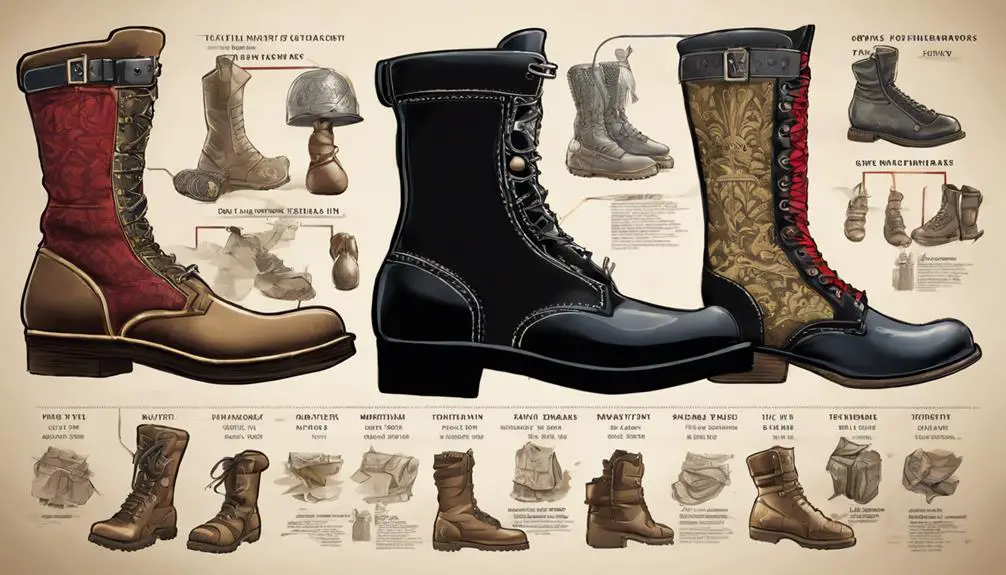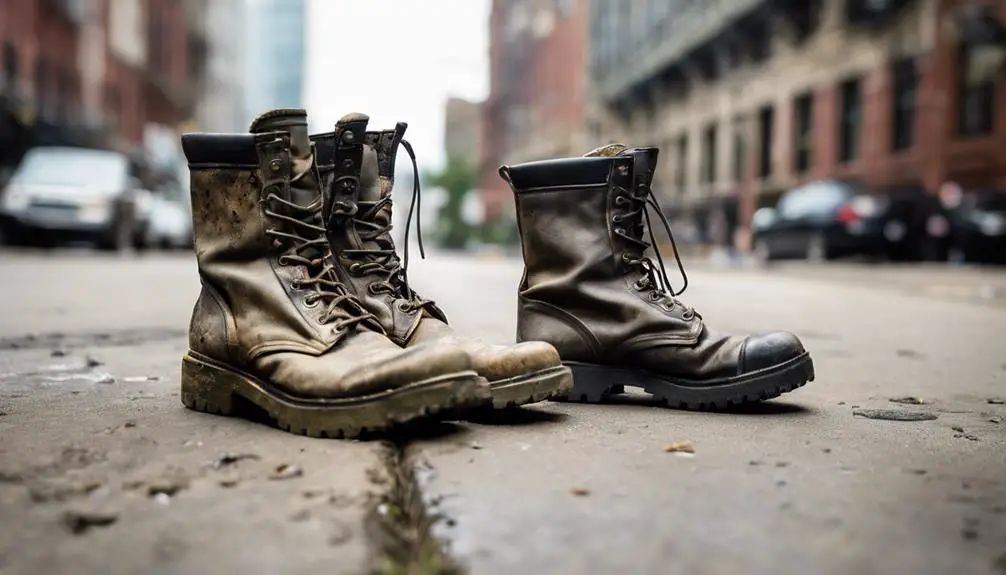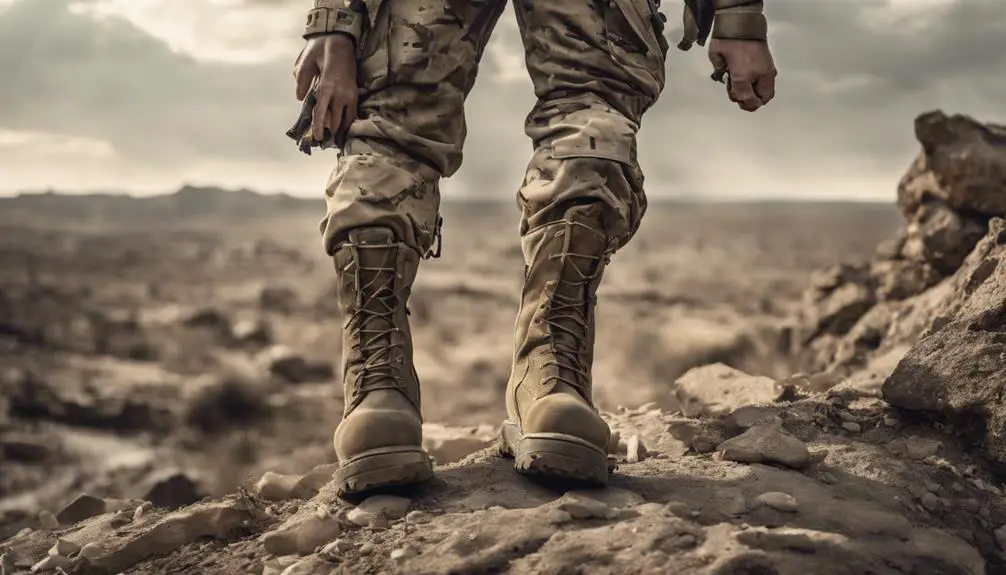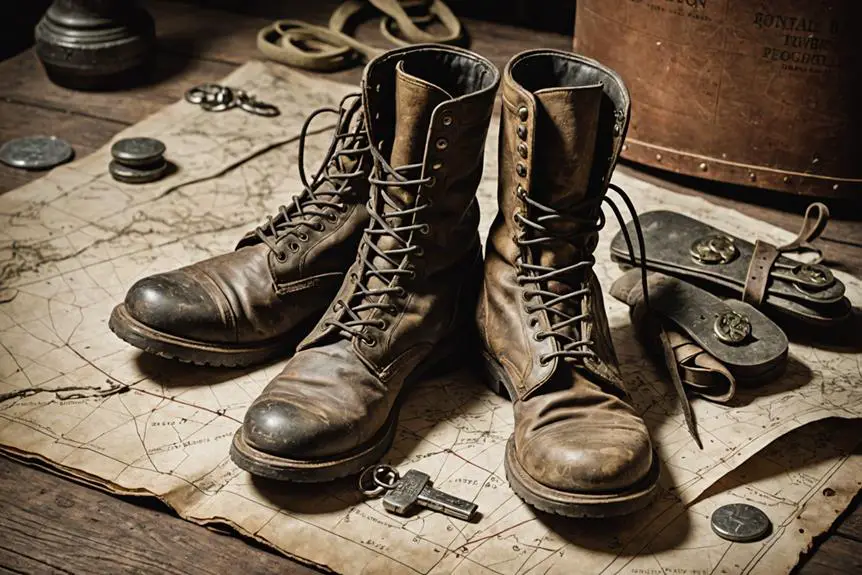It's a coincidence that you might find yourself wearing combat boots today, as they've been a staple in military gear for centuries. From the sturdy caligae of Roman legions to the modern technological advancements in today's footwear, each evolution has reflected the changing demands of warfare. You may wonder how these boots became essential not just for soldiers but also in fashion and culture. Understanding this journey reveals much about their design, functionality, and the impact they've had on soldier performance throughout history. What else might surprise you about their transformation?
Historical Evolution of Combat Boots

Throughout history, combat boots have undergone significant alterations to meet the evolving needs of soldiers. Can you imagine the Roman soldiers stomping around in their hobnail boots called caligae? Fast forward to the late 1st century, and you'd see these boots evolving into more protective calceus footwear. By the 19th century, the US military and other forces started rocking ankle and calf-high boots, like the Jeff Davis boot introduced in 1858, which focused on comfort and durability.
Now, when World War I hit, the need for better gear was essential. Enter the Pershing boot! This heavy-duty boot featured iron plates and cowhide soles, perfect for tackling the muddy trenches and combatting immersion foot syndrome. Fast forward a bit more to the Vietnam War, and you'd find the M-1966 jungle boot making waves. It combined black leather and olive drab canvas, designed specifically for moisture management and durability.
With the end of the Vietnam War came a big change in military footwear aesthetics. The alteration to shined black combat boots started in 1957 and became the norm by the war's conclusion. Talk about a stylish upgrade!
Global Variants and Developments
As military needs evolved, so did the design and functionality of combat boots across the globe. Take the Australian Defence Force, for example. They adopted the Redback Terra Combat Boot in 2000, but ran into sizing issues and worries about sole durability. They're still on the hunt for something better! Meanwhile, Argentine combat boots have come a long way from those old hobnail designs to modern versions equipped with robust rubber soles. Talk about an upgrade!
Over in Belgium, the combat boots marked by ABL have seen variations in sole designs since the 1970s. Stitched rubber soles became a game changer, enhancing functionality for soldiers. In India, it's a bit different. Their military boots have remained mostly unchanged for a whopping 130 years! But don't worry, new designs are in the works to tackle snowy conditions.
Now, let's not forget Russia! They shifted from the classic jackboots of the Imperial Army to ankle boots during WWI. By 2007, they finally embraced modern combat boots to boost soldier performance. It's fascinating how different countries have their own unique approaches to tactical boots, isn't it?
These global variants show just how much footwear evolution matters in the military world. Each design reflects a commitment to overcoming durability issues and improving soldier performance. Whether it's a sleek modern version or a historical design, combat boots continue to adapt, ensuring our brave soldiers are ready for whatever comes their way!
Modern Challenges and Standards

When it comes to modern combat boots, you've got a lot to contemplate! With standards like AR670-1, they need to be tough, comfortable, and ready for anything—whether you're in the desert or facing the cold. Isn't it impressive how much thought goes into making sure your boots can handle whatever the military throws at them?
Evolving Design Requirements
Adaptability is essential in today's military environment, where evolving design requirements for combat boots reflect the diverse challenges soldiers face. Modern combat boots aren't just about looking tough; they have to meet strict military standards like AR670-1. That means height, materials, and soles are all vital. You want boots that are 8-10 inches high, made of genuine leather, with rubber or polyurethane soles for durability and traction.
Thanks to innovations, today's boots are lighter and more comfortable. They often incorporate ergonomic designs and advanced waterproofing technologies like GORE-TEX, so you can stay mobile no matter the weather. Plus, soldiers now get multiple pairs suited for hot or temperate conditions, ensuring adaptability to all terrains.
Continuous feedback from troops drives these innovations, pushing for better ankle support, moisture management, and even insulation for extreme conditions. It's like a constant upgrade to combat footwear, keeping you ready for anything! Who knew boots could be so complex? But hey, if they keep you comfy and agile, that's a win in our book! So, next time you lace up, appreciate the design incorporated to keep you at your best!
Environmental Adaptation Standards
Modern combat boots face a myriad of environmental challenges that demand strict adaptation standards. You might not realize it, but these boots are more than just tough shoes. According to the U.S. Army manual AR670-1, modern combat boots need to be at least 8 inches tall, made from genuine leather or synthetic materials, and have sturdy rubber or polyether polyurethane soles. Why? Because soldiers need reliable gear in hot weather and temperate conditions!
When it comes to battling the elements, features like shock-resistant rubber soles and breathable materials are lifesavers. And don't forget about ankle support—it's essential for keeping you steady on rough terrain. Each pair of combat boots is designed to adapt to various environments, with two pairs for hot weather and one for temperate conditions.
Plus, the design innovations don't stop there! Continuous feedback from soldiers helps improve comfort and performance, ensuring boots can handle whatever challenges come their way. So, the next time you see a soldier's boots, remember: they're engineered for survival, adapting to the wild world out there! Isn't that awesome?
Design Features and Functionality
When you think about combat boots, you might picture tough guys stomping around in the mud, but there's way more to them than that! From high tops that keep your ankles safe to super grippy soles that help you stay steady on slippery surfaces, these boots are all about function. And don't forget the cool tech—like waterproofing and insulation—that keeps your feet warm and dry, making sure you can tackle any adventure that comes your way!
Traction and Stability Features
Combat boots are engineered with a variety of traction and stability features that make them indispensable for military personnel. You'll notice that the specialized cleats and treads on these boots give you a serious grip on all kinds of terrains. Whether you're marching through mud or sprinting on rocky ground, you can trust their stability to keep you moving confidently.
The rubber sole isn't just for show; it's designed to be shock-absorbing, helping to reduce foot injuries during long days on your feet. Plus, with high-top designs, you get that much-needed ankle support, so you won't be worried about twisting an ankle while you're in action. Durability is key too. Combat boots are made from tough materials, with reinforced stitching and molded soles, ensuring they stand up to the roughest conditions.
And let's not forget about performance! The combination of these features means your boots aren't just footwear; they're a reliable partner in the field. So, next time you lace up, remember all the thought that goes into making those combat boots work for you!
Waterproofing and Insulation Technologies
The design of combat boots goes beyond traction and stability; waterproofing and insulation technologies are equally important for peak performance in diverse environments. Imagine trudging through a muddy battlefield—your feet need to stay dry! That's where advanced waterproofing comes in. Many modern combat boots feature GORE-TEX, a magic material that helps keep your feet dry while still being breathable. Talk about a win-win!
Now, if you're facing cold-weather conditions, you want combat boots that can handle extreme temperatures. Enter the Mickey Mouse boots! These bad boys can withstand temps as low as -60°F, ensuring your toes stay warm when it's freezing outside. Plus, with moisture-wicking materials, sweat doesn't stand a chance, reducing the risk of blisters and other foot issues.
And don't forget about lightweight, durable synthetic materials. They provide insulation and waterproofing without weighing you down. Isn't that awesome? So, whether you're in the rain or snow, today's combat boots have your back (and feet) covered with all the right features. Who knew staying dry and warm could feel so good?
Comfort and Fit Considerations
Comfort is key in combat boots, ensuring you can perform at your best without distraction. When you're out in the field, you don't want to be thinking about sore feet. Modern combat boots prioritize comfort with some amazing features. Here's what to look for:
- Ankle Support: Proper support keeps your feet steady and reduces fatigue.
- Lightweight Materials: These help you move quickly and easily, whether you're in mud or on rocky terrain.
- Customization Options: From adjustable ankle heights to interchangeable insoles, you can tweak your boots to fit your needs.
Also, don't forget about waterproofing technologies like GORE-TEX, keeping your feet dry and happy. Breathable leather and shock-resistant rubber soles add to that comfort, letting you focus on the mission, not on blisters. Military specifications require boots to fit just right, so make sure you find the size that works for you—8 to 10 inches tall is the norm. With all these features, modern combat boots are designed for ultimate comfort and fit, so you can conquer any challenge that comes your way! Ready to lace up?
Impact on Soldier Performance

Boots play an essential role in a soldier's performance, as their quality and design directly impact mobility and endurance on the battlefield. Think about it: when you're out there, every step counts. If your combat boots are uncomfortable, you're not just complaining; you're risking your performance. Poorly designed boots can lead to injuries, like trench foot, that could slow you down or even take you out of the fight.
Today's boots are a far cry from what soldiers used in the past. Thanks to advances in technology, we now have shock-resistant rubber soles and breathable materials that keep your feet comfy during those long missions. And let's be real—who doesn't want to avoid blisters? Specialized boots designed for different environments, like deserts or jungles, give you the traction and support you need to navigate tricky terrains.
Plus, innovations like waterproof and insulated designs are game-changers. They help prevent foot-related health issues that could compromise your performance. It's all about keeping you on your feet and ready for action! Continuous feedback from soldiers has pushed these designs forward, focusing on fit and functionality to make sure you can handle whatever comes your way.
Advancements in Technology and Design
Military combat footwear has undergone remarkable transformations thanks to advancements in technology and design. Today's combat boots aren't just tough; they're engineered for performance! With the right pair, you can tackle any terrain without breaking a sweat. Want to know what makes modern combat boots so special? Here's a quick list:
- Shock-Resistant Soles: These boots feature shock-resistant rubber soles that absorb impact, making each step more comfortable and safe.
- Moisture Management: Lightweight waterproof materials like GORE-TEX keep your feet dry during those intense missions, so you won't be squishing around in soggy socks.
- Breathability and Insulation: Cold-weather boots are designed to handle extreme temperatures, sometimes as low as -60°F, thanks to multiple layers of insulation.
But that's not all! Ergonomic designs offer fantastic ankle support, which is vital for mobility and reducing injury risks. Plus, with continuous research, you now have removable insoles for customizable comfort. Who wouldn't want to adjust their boots to fit just right?
Whether you're on the front lines or just wandering through your neighborhood, these innovations make a real difference. So, next time you lace up your combat boots, remember that every step is backed by cutting-edge technology and thoughtful design. Isn't that awesome? Grab a pair that works for you, and you'll see why these advancements matter!
Frequently Asked Questions
When Did Soldiers Start Wearing Boots?
As you lace up your boots, consider that soldiers began wearing them in ancient times, symbolizing protection and tactical advantages. Over centuries, military evolution shaped their design, materials, and comfort, influencing both function and fashion.
When Did the Army Stop Running in Combat Boots?
The Army stopped running in combat boots in 2015, prioritizing military footwear technology and comfort features. This shift improved performance and reduced injuries, aligning with modern training needs and evolving boot materials and designs.
Are Combat Boots Actually Used in Combat?
Did you know that 90% of soldiers report improved performance with modern combat boots? These military footwear innovations, with tactical design and comfort features, enhance ankle support and sole technology, blending historical evolution with fashion influence and cultural significance.
What Do Combat Boots Symbolize?
Combat boots symbolize resilience and durability standard, reflecting military tradition and veteran pride. They've evolved into a rebellion icon and fashion statement, embodying cultural significance, gender equality, and the historical evolution of tactical footwear.




